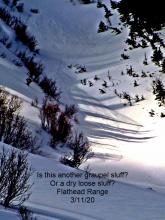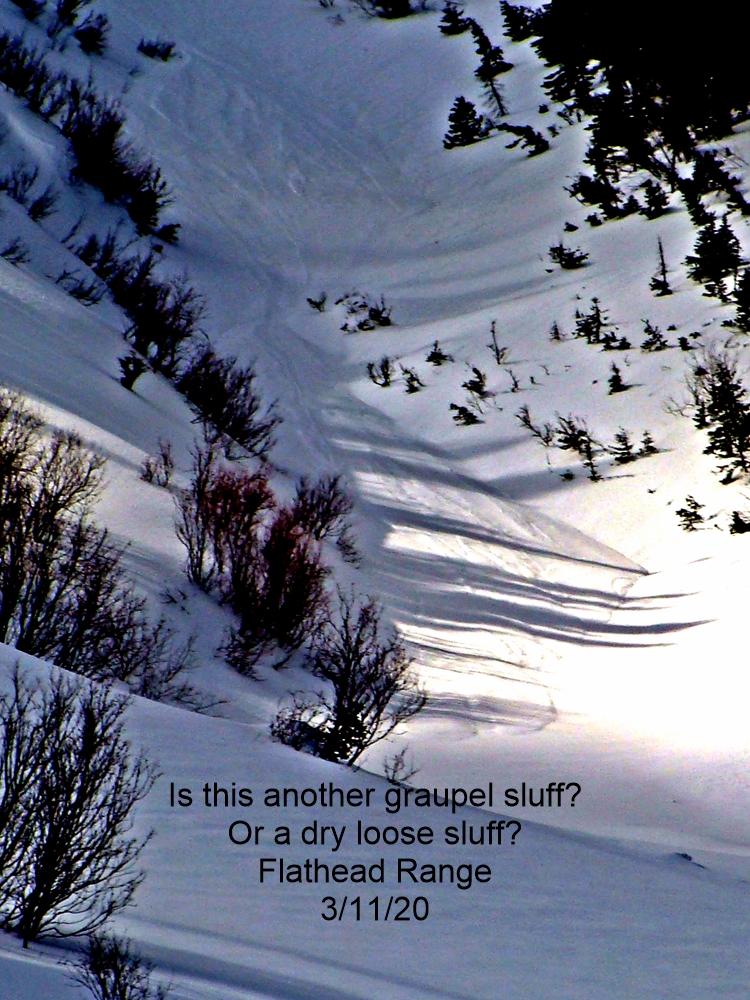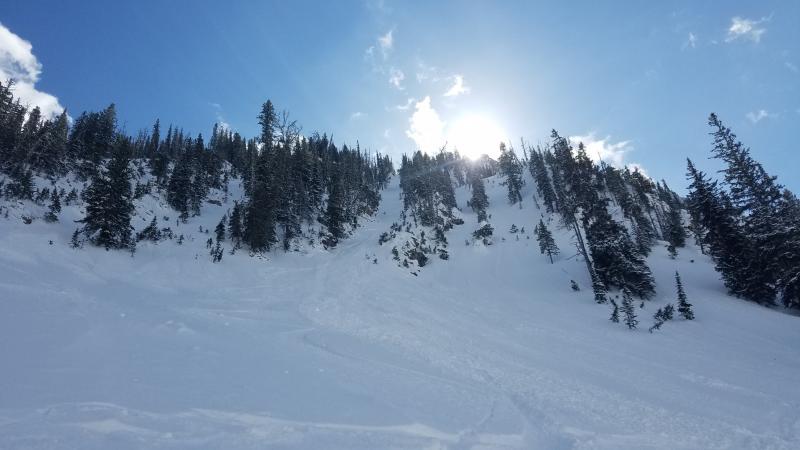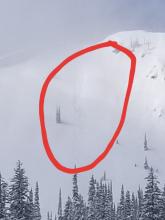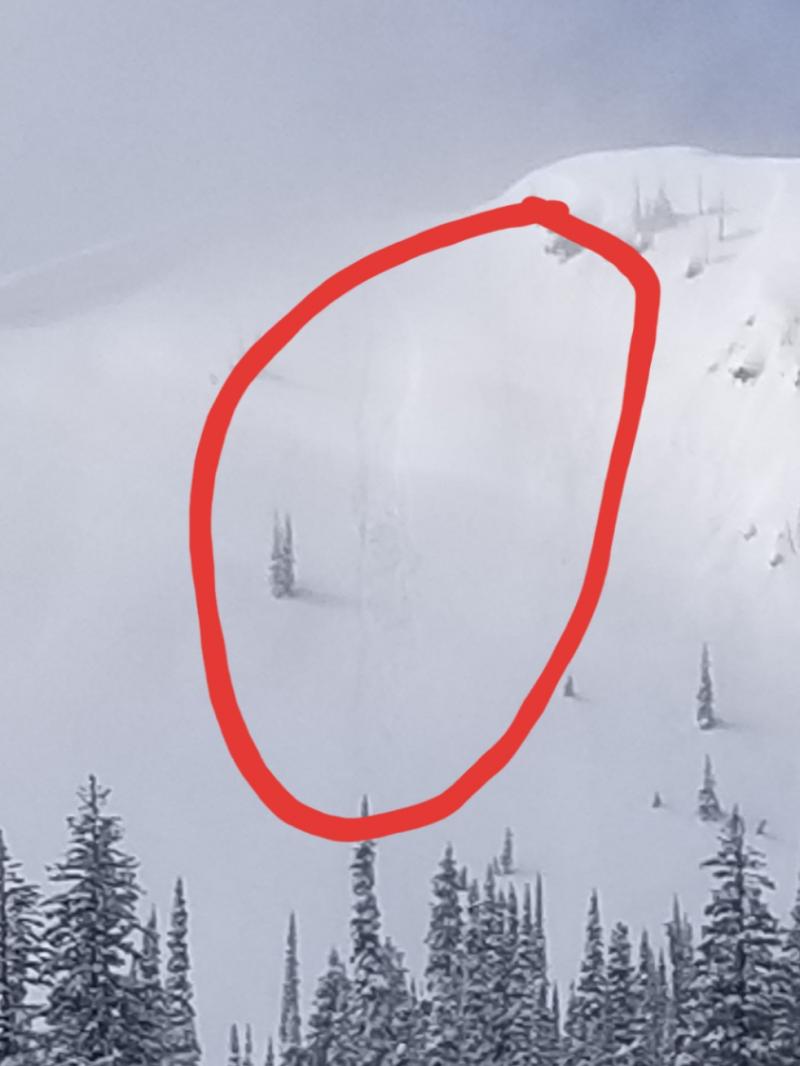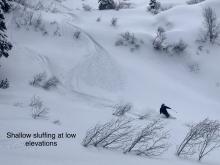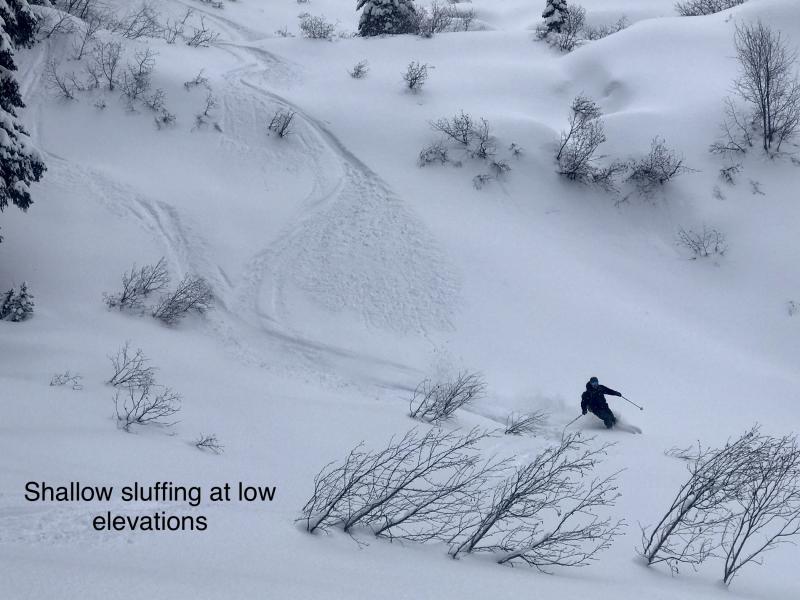| Sunday | Sunday Night | Monday | |
|---|---|---|---|
| Cloud Cover: | Light snow showers tapering late morning. | Increasing light/moderate snow. | Continued snow with rising snow levels. |
| Temperatures: | 26-36 deg. F. | 22-27 deg. F. | 28-37 deg. F. |
| Wind Direction: | W-SW | S-SW | SW |
| Wind Speed: | 7-12 gusts 17-23 | 7-10 gusts 20-23 | 9-15 gusts 20-32 |
| Snowfall: | 0 in. | 2-4 in. | 2-3 in. |
| Snow Line: |
Whitefish Range
Swan Range
Flathead Range and Glacier National Park
How to read the forecast
Given the variability in the snowpack across the advisory area it is important to make conservative terrain choices and carefully evaluate the snowpack before skiing or riding on a slope. The avalanche danger is CONSIDERABLE above 5000 feet and MODERATE below 5000 feet. Weak snow in some places remains buried under unconsolidated snow and is waiting for the right conditions to form a slab and become reactive like rising temperature, increased wind, and continued settlement.

3. Considerable
?
Above 6500 ft.
3. Considerable
?
5000-6500 ft.
2. Moderate
?
3500-5000 ft.
- 1. Low
- 2. Moderate
- 3. Considerable
- 4. High
- 5. Extreme
-
Type ?
-
Aspect/Elevation ?
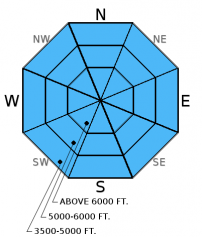
-
Likelihood ?CertainVery LikelyLikelyPossible
 Unlikely
Unlikely -
Size ?HistoricVery LargeLargeSmall

There is a lot of variability across the advisory area with this problem that warrants careful snowpack evaluation and cautious route-finding. Surface hoar and weak, faceted snow were observed in all ranges, but you won't find them on all slopes. These weak layers are now 1.5 to 4 feet deep after the recent storm. Surface hoar is notorious for propagating long distances across a slope, around corners, and through the trees. In places where the environment is just right to preserve surface hoar like shaded and sheltered areas a slab may also be late to form over these layers. Given the tricky distribution of these persistent slabs it would be wise to avoid steep, open slopes and convexities. Look for obvious signs of instability like recent avalanche activity, shooting cracks, and whumpfing.
-
Type ?
-
Aspect/Elevation ?

-
Likelihood ?CertainVery LikelyLikelyPossible
 Unlikely
Unlikely -
Size ?HistoricVery LargeLargeSmall

Recent wind slabs formed on top of a variety of surfaces that can cause instability to linger including sun crusts, freezing rain crusts and buried surface hoar. BNSF Avalanche Safety intentionally triggered a wind slab on Thursday on a test slope and observed recent natural wind slab activity on easterly and northerly aspects. Wind slabs will be thicker at upper-elevations in the precipitation favored Swan Range and in areas near the Continental Divide where wind speeds have been stronger. Look for smooth, rounded features on the slope especially on steep convex rollovers, on leeward sides of ridges and cross-loaded gullies. Wind slabs could be over 4-5 feet thick making them very dangerous.
-
Type ?
-
Aspect/Elevation ?
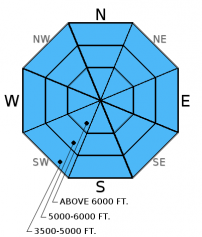
-
Likelihood ?CertainVery LikelyLikelyPossible
 Unlikely
Unlikely -
Size ?HistoricVery LargeLargeSmall

This problem will be amplified in the Swan Range where the snow is deeper, and in many areas remains dry and unconsolidated. The potential exists for loose, dry avalanches to knock you off your feet or sled and even entrain enough snow to bury you. Use extra caution when traveling near terrain traps like narrow gullies, steep treed areas, and cliffs. With temperatures inching closer to the freezing mark watch for signs of increasing loose, wet avalanche danger if temperatures rise more than expected. Early signs of instability include surface snow that becomes moist and roller balls forming steep slopes and cutbanks.
Deeper layers in the snowpack like the December 9 rain crust and weak snow near the ground in areas with a shallow snowpack are unlikely to be awakened during this storm, but it's not impossible. As you dig deep into the snowpack you will encounter the remnants of the December 9 rain crust. This crust/ice mass is a good landmark to monitor as the season progresses.
Yesterday, we were in Noisy Basin in the Swan Range where we saw widespread recent avalanche activity (photo). Several of the the avalanches were relatively shallow and occured early in the recent storm cycle, while others failed on the weak snow formed in early Jan. and were 3-3.5 feet deep (observation).
Skiers in the Flathead Range yesterday also noted recent avalanche activity and found instability within storm snow and on the Jan. 12 freezing rain crust (observation). Skiers on Ghoulie Point in the southern Whitefish Range found a freezing rain crust buried 2 feet deep in the snowpack that was minimally reactive in stability testing. A seperate party of skiers on Skookoleel Face, also in the southern Whitefish Range found the new snow/old snow interface to be reactive in stability testing (ECTP 16 Q2 35cm from the surface). Snowmobilers in the six-mile area in the Swan Range reported recent natural activity. They estimated the width at 100 feet with a 2-3 foot crown.
On Friday a party of skiers triggered multiple avalanches that were reported as 16 inches deep. These avalanches occured on the south side of Ghoulies outside of the ski area boundary in the southern Whitefish Range. One skier was caught and carried through the trees, and luckily only sustained minor injuries. BNSF Avalanche Safety reported a natural avalanche in the Java Creek drainage in the Flathead Range (photo). Another natural avalanche was observed by a group of snowmobilers riding on Doris Ridge in the Swan Range.
On Friday we were in the Lost Johnny and Doris Creek drainages in the Swan Range and found up to 2.5 feet of recent, unconsolidated snow at low elevation. Though the rain that came with the arrival of the system began to decompose buried surface in the mid-elevation band, it was still present in the snowpack.
Thursday, Erich easily triggered a storm slab (12-16 inches deep and 50 feet wide) from the top of a flat, safe ridge just east and outside the boundary of Whitefish Mountain Resort (video, photo). The slab failed on the freezing rain crust that formed Wednesday (1/12/2016).
Also, on Thursday in John F. Stevens Canyon in southern Glacier NP, BNSF Avalanche Safety observed 3 natural wind slab avalanches and intentionally triggered another on a test slope (photo, observation). The deepest part of the slab was 50 inches deep and failed on buried surface hoar.
Skiers in the Swan Range Thursday stated they stuck to low angled slopes in tight trees, but experienced collapsing (whumpfing) of the snowpack numerous times. They also observed shooting cracks and sensitive storm slabs on small, steeper rollovers (observation).
In the Marion Lake/Dickey Creek area of the Flathead Range Wednesday Erich observed active wind loading and a developing wind slab on near surface weak layers (observation, video). Wednesday, skiers in the southern Whitefish Range found buried surface hoar about 4-5 inches below the surface, and noted localized shooting cracks on this layer (observation). Skiers in the Skyland area found buried facets a few inches below the surface and recent wind slab activity on Slippery Bill Mountain (observation).
Thanks to everyone for submitting observations. They are extremely useful for everyone.
Visit our Observations page and our You Tube channel for more observations from the entire season.
Please let us know what you are seeing out there. Your observations are important and valued.
HOW TO SUBMIT OBSERVATIONS:
Email: [email protected]
Call and leave a message: 406.387.3821
You can also submit quick observations via text: 406.241.4571 (FAC mobile)
OR
Submit Snowpack Observations: http://www.flatheadavalanche.org/node/add/snowobs
Submit Avalanche Observations: http://www.flatheadavalanche.org/node/add/avyobs
In the past 24 hours we picked up an additional 2-4 inches of snow, and winds were light out of west and southwest. Currently, temperatures range from 21º-27º F and winds picked up a bit and are blowing out of the southwest at 5-10 mph with gusts to 22 mph. Today, snow showers should taper mid-day and resume this evening. Temperatures will rise to the mid to upper 20s and winds should remain out of the southwest at 5-15 mph with gusts in the 20s on high ridgelines.
| 0600 temperature: | 21-27 deg. F. |
| Max. temperature in the last 24 hours: | 21-28 deg. F. |
| Average wind direction during the last 24 hours: | WSW |
| Average wind speed during the last 24 hours: | 3-5 mph |
| Maximum wind gust in the last 24 hours: | 15-20 mph |
| New snowfall in the last 24 hours: | 2-3 inches |
| Total snow depth: | 54-77 inches |
This advisory applies only to backcountry areas outside established ski area boundaries. This advisory describes general avalanche conditions and local variations always occur. This advisory expires at midnight on the posted day unless otherwise noted. The information in this advisory is provided by the USDA Forest Service who is solely responsible for its content.

























